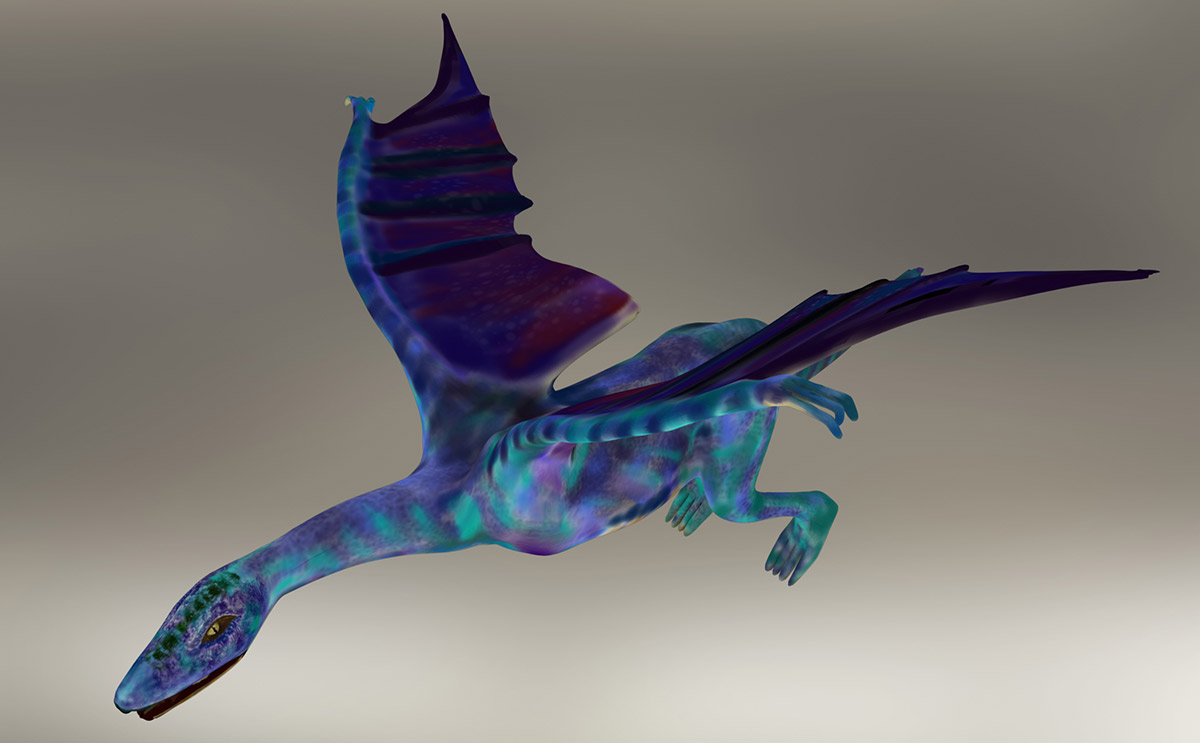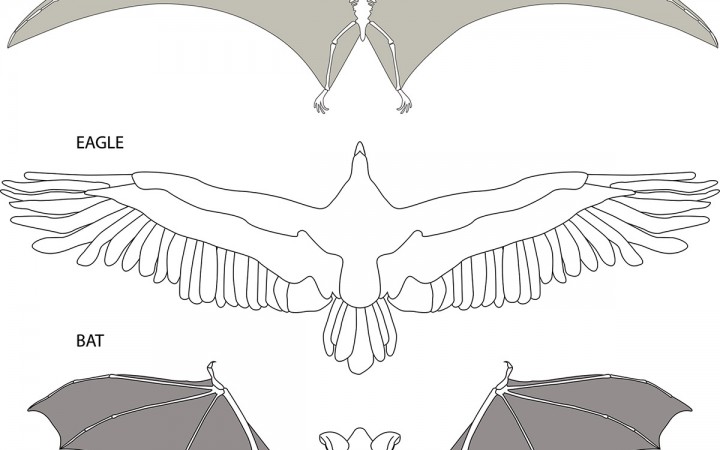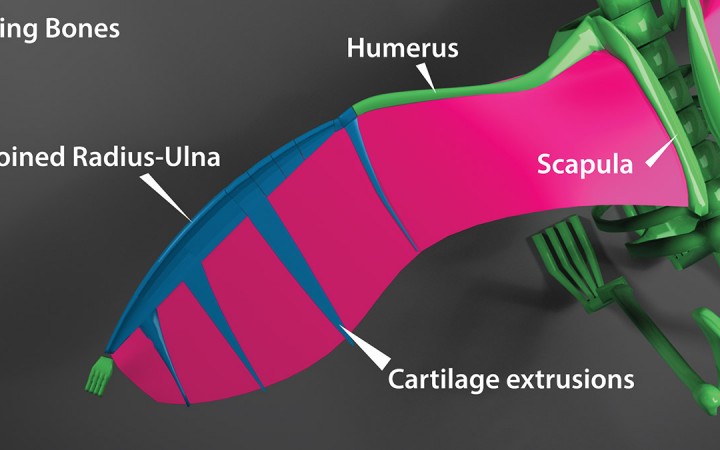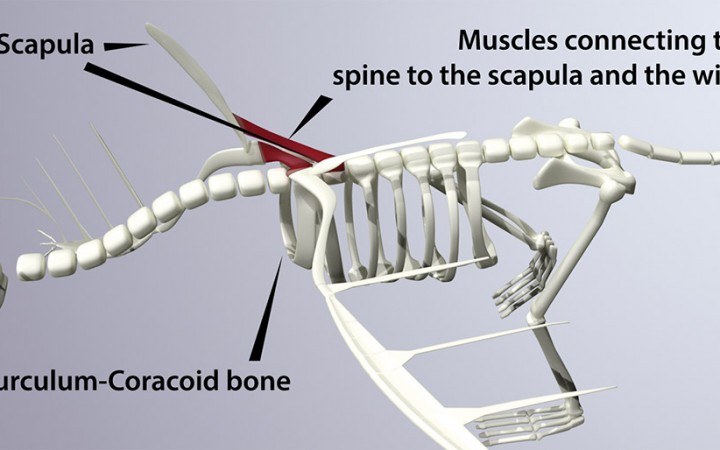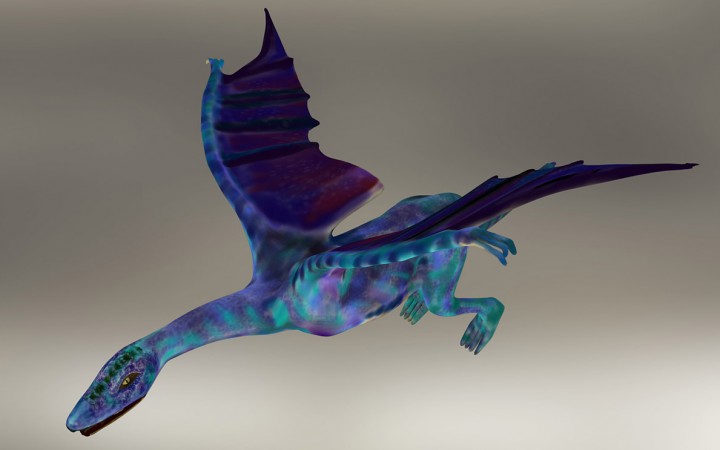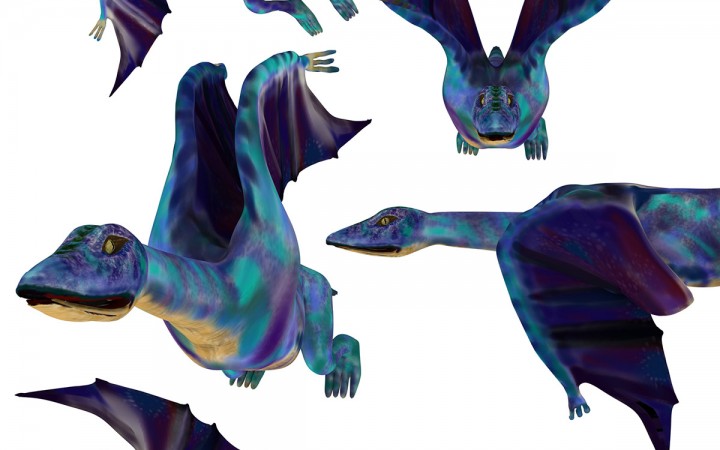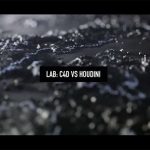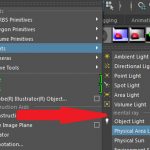Abstract
Dragons have a very important role in fantasy stories and have become a staple of animation and visual effects in live action movies and videogames. However a lot of dragon animations to date show biologically unrealistic flight movements. I propose a new design of a dragon skeleton that allows realistic flying animation while preserving all the physical characteristics that we expect to find in dragons. The new wing design allows for a greater range of movement and is also fully compatible with motion capture technologies.
1. Introduction
1.1 The complexity of flying.
Flight is a very complex mater. It involves beating gravity and at the same time achieving movement from point A to point B. Compared to animals, flying on airplanes is simpler because the thrust (forward movement) is separated from the lift provided by the wings. In animals wings are responsible for overcoming drag, lift and thrust. For an animal to fly wings need to move the fluid in two directions, up and forward. Lift is the force that makes the animal go up.
This gravity-defeating force is perpendicular to the drag and is dependent upon wing area. Therefore the shape and size of wings determine the impact that an animal can have in the air i.e. the way it flies. Thrust is produced by the flapping of wings. Thrust opposes drag and it works by pushing the air in the opposite direction of where the animal wants to go. In order to fly an animal needs to generate a movement in two directions, up and forward with enough strength to beat both the drag created by air and the downward force generated by gravity. [1].
1.2 Adapting a very real movement to an animal that does not exist.
The biomechanics of flight depend on the shape of the animal, the geometry and the size of its wings. Even among the same class of animals, different species show diversity on the way they move in order to fly. One of the biggest differences occurs between a membrane wing, as possessed by bats, and a feathered wing as shown by birds. Membrane wings cover the whole body connecting the upper and lower limbs. The wings of birds however, are only connected through the humerus bone, leaving the feather tips to fly freely.
Figure. 1 shows the wing shape on a pterodactyl (a pterosaur), an eagle and a bat. Knowing these shapes is key for understanding the problems with dragon wings.
1.3. The problem with dragon flight.
Dragons were most likely imagined by people who found dinosaur skeletons [2]. Through the stories ancient people made, a common dragon shape was established as an animal with a dinosaur like body and a long tail and neck. Its wings were made of skin and featured separations like those of bats, but had the shape of bird wings, growing long perpendicular to the body. Usually the membrane that makes the wing is kept in shape by its attachment to the dragon’s wing bones and is tensed by being attached to the dragon’s torso. However, a dragon like this cannot perform a mechanically correct flying cycle. If it were to do so, the membrane would break from the massive extension and tension upward and forward that it will have to do when flying. What this wing can do is simply move up and down. For a casual observer flying only consists of flapping the wings up and down so at first glance, this type of flying in a dragon did not seem wrong. Until photography and high speed cameras, the actual complexity of the movement of wings was not understood.
1.4 The movement of flying in animation and how 3d changed everything.
Like any other art, animation on its origins was purely based on observation and instinct. As animation started with very unrealistically drawn characters, looking for realistic flying movement in them was not necessary. The stylization of drawings meant that as long as the movement looked smooth it was acceptable.
However 3d animation changed this. The idea behind 3d Computer Generated images is generally to make things look more real. It started with creating objects with volume, later with increasing the realistic and detailed look of objects and characters and finally with refining the movement of creatures as we see in movies such as Tron (1982) with its tridimensional environments, Jurassic Park’s (1993) realistic looking dinosaurs and Avatar’s (2009) fluid character motion capture. All the technology behind the development of computer generated images seeks to expand reality on a screen. Computer simulations and motion capture are the latest advancements in making these human created worlds look more like nature. But all of this technology development has not always been applied properly to flying animals. In both live action and animated movies, flying creatures are usually animated like airplanes. They flap their wings but most of the time they just glide and turn the same way as airplanes do. Fixing the flying animation for a bird or bat is not that difficult as it involves simply modifying the rigs and changing the animation. However the wing problem described above (1.3) complicates the proper animation of a dragon because does not allow for a realistic animation of flying with a membrane wing.
The aim of this paper is to propose a design for a dragon that keeps its dinosaur looks but that has the ability to be animated to fly correctly.
2. Understanding flying.
2.1 Requirements
In order to fix the problem with the dragon’s wing it is essential that the movement of flying in bats and birds is understood. This will give us the parameters to create a wing that can fly. There are also artistic considerations, mainly what forms will look good on screen and allow for the creation of interesting characters.
2.2 The flying of bats
Bat wing movement centers on the shoulders of the animal. Unlike the common flying representation of an up and down motion of the wings, bats generate lift and thrust by moving its wings completely forward, rotating its wings counterclockwise and scooping the air with the wing back and down in the same movement. Then they rotate the shoulders, and the wing moves upwards in a circular motion repeating the process. Bats also get help from their legs. As they are connected to the wings, legs go up and down providing extra lift. It is synchronized with the wings so that when the wings are scooping and pushing the air, the legs are kicking down helping the bat stay in the air. [3]. The flying movement of bats can be understood better if you swim, as the butterfly style that you see in competitive swimming is a carbon copy of their flight.
Figure 2 illustrates the movement made by bats and birds while flying and a human while swimming butterfly. The swimming example is relevant because its movement is human made and there are lots of explanations and videos on how it is done. This can be a very useful complement to an animator looking to animate a flying animal.
2.3 The flying of birds
Although dragons have membrane wings, the geometry of their wings appears to be generally based on that of a bird, since they are wide but not very long. Bird wing movement is less extreme than that of a bat, but it is still far more complex than plain up and down flapping. The main lesson that we get from studying the flying of birds and bats is that its movements involve complex tridimensional rotations and pull the wings tremendously in all directions, which the wing of a dragon as we know it cannot do.
2.4 The problem of the dragon wing in an animation environment
If you try to animate a realistic flying cycle with a traditional shaped dragon, animation, rigging, modeling and rendering issues are going to appear. It will need a lot of polygons on the wing in order to compensate for the greater area when the wing is extended. If you were to try and push the traditional wing forward like we see in a bat, the polygons would extend too much. This will bring problems to the textures as the area that they are covering will have a different form than in resting position. Most of the vertices will have changed the position with each other, those sharing the Z axis (assuming axis as X sideways, Y up and Z depth) edge will be more separated and those on the X axis, many of which will be overlapping . The solution would be to use ultra-high resolution textures, thus increasing memory usage and rendering times.
Another issue of concern is that geometry in the positions between the wings on its resting position to its maximum extension can easily collapse. The massive change in the topology’s form will make the polygons explode and push vertices to places where they should not be. Controlling this will require a lot of extra work in defining specific deformation points and a limitation on what the animator can do without breaking the model.
Another factor is that every solution for the problems described above will come at the expense of increasing the amount of polygons on the wing as the shape and textures must be maintained at the most extreme positions. However the very high geometry means that when resting or when the wing folds, there can be a lot of overlapping between vertices which will mess up the rig, the model and the final render. Most of these issues can be worked out at the expense of a lot of time from artists and coders, computer power and money. The way around of all these problems is to come up with a new design for dragon wings.
3. Proposing a new dragon.
3.1 Determining the form that allows for a correct flying animation cycle.
The first step to creating our dragon must be to decide how to fit a wing in the dragon body. The most obvious thought is to fit the wing of a pterosaur, after all we know that they could fly so we must be able to animate them properly. But will this character be photogenic? Would the character be compatible with human driven motion capture like we see in The Hobbit movies [4]? The Pterosaur wing will cause the back legs to need modification. Because the Pterosaurs front and back legs are connected, its movement range in land is limited. This is a problem from an acting point of view as this pterosaur winged dragon could not do very dramatic poses or action movements.
Another important consideration is how many limbs the dragon can have. Mythological flying creatures like Pegasus and griffins have six limbs. These fantastic animals have served as reference to six limbed dragons on movies; however no animals with bones have more than four limbs. Insects have six legs and wings that did not evolve from forelimbs but their design is so different from a dragon that any character based on them will be a completely different animal than the dragons we are used to. If we decided to use insect wings in a six limbed dragon, these wings would move so fast that they would be seen as a big blur and significantly reduce the majesty of the dragon. The other problem is that having six limbs (four legs and two wings) does not allow big wings to move enough because if they move forward or backward they will collide with the legs. As discussed earlier, shoulders are key to the movement of wings and if you have six limbs there is no space for the muscles of the legs, or the wings. The six-limbed dragon would not look like a living creature (important for the world of 3d animation). Alternatively, if there is a big longitudinal space between each pair of limbs, it will completely destroy the proportions of the animal and it will not look good on screen.
The four-limbed dragon is the ideal shape because it keeps animal proportions right and it enables the building of all the correct muscles. It can be animated it with a lot of freedom and realism. It is also suitable for motion capture technology as the wings can easily be controlled by the arms of the human performer.
3.2 Designing the wings
The crucial part of the dragon is the shape of the wings. There has to be a separation between the wing membrane and the body. The geometry of a bird wing works better because it allows for a more animation-friendly body. If the membrane is separated and placed like a longitudinal bone at the beginning of the wing there will be visual problems. The first one is purely aesthetical and it is that there would be a big gap between the wing and the body. If the humerus bone is thin or the color contrast on the final image is soft, you risk not seeing the wing as part of the dragon. If it is too close to the body there will be a collision between this bone and the body on extreme rotations, which are needed for animating the flying cycle and when the wings are posed as arms.
4. The Final Design.
4.1 Description of the skeleton
This design is based on a skeleton as it is a template to model the final appearance of the creature at will.
The measurements and proportions of the dragon are arbitrary. Because it is not a real animal its size and final shape can be adapted to the tastes or needs of the movie it is going to be in. The body of this dragon resembles that of a four legged mammal. The back legs are connected to the spine with an ilium bone; so is the tail vertebrae. The back legs are of a plantigrade, an animal that walks with its whole feet planted to the ground for example humans and bears [5]. Such a massive animal could not just stand on its toes, since that would make the character performing and moving the lower limbs look very flimsy. It also helps with connecting a motion capture system to the dragon.The spine is a regular vertebrate column. The neck consists of cervical vertebrae that connect the body to the skull. There is a set of ribs that give shape to the chest and the bottom part of the body. This design does not deviate from what you will find on a traditional big mammal or dinosaur.
Figure 3 shows how the skeleton is assembled. It is constructed from real bones combining those of land mammals and birds.
4.2 Construction of the wings and its supporting bones
The wings are attached to the body with furculum and coracoid bones like the ones in a bird. From there the wings extend with a humerus followed by a merged radius-ulna bone and finalizing with a carpometacarpus and phalanges which are placed like a hand. This final part is to accommodate the acting of the character through motion capture. Most likely the dragon will interact with humans. This means approaching them so that their faces will be close in order to fit in frame. Its hands give it the possibility of poses that allow more framing choices.
Figure 4 shows the bones of this proposed wing.
4.3 The key bone, the floating scapula
The key problem is that in order to have a membrane wing it needs to be attached at both ends so that the membrane is extended and can actually function as a wing. The solution is a large floating scapula.
The scapula is located on top of where the humerus and the coracoid begins. It is connected with muscles to the first and second vertebrae of the dorsal, this way the scapula can rotate freely. From the scapula the membrane wing can be attached and work properly. Another benefit is that because the scapula is on top of the body there is not a gap between the body and the wing, giving it a bigger wing and a more cohesive character. In
Figure 5 we see the scapula and how it is connected to the body. Muscles connected to the first two vertebrae allow it to move freely driving the wing’s rotation.
4.4 The structural bones that tense the wing.
In a bat or Pterosaur you see dividers that separate the wing into several sections. These bones are the evolved version of fingers. This presents a problem for the dragon if you need it to retain regular looking hands or claws. The solution implemented is that from the radius outward the wing has several protuberances from the bone growing backwards. These are tapered at the end and are nothing more than extrusions of the wing. If this was a real creature they might be made of cartilage. The end of these bones is curved and has two tips. In this way the dragon has a bigger wingspan and the hand/paw can rotate freely.
4.5 The flesh – skin body
This body is very flexible, it can accommodate stylized cartoon or very realistically-looking bodies. The muscles that cover the femur on the back legs are attached to the body like in any mammal [6].
Figures 6 and 7 show a cartoony dragon in various flying poses. It has a very wide range of wing movement. The wings always keep their dimensions, even during extreme movement, so textures and rigs will not deform or limit its animation capabilities. It works with a low polygon count. This one only has 17,570 polygons.
5. Conclusions
The hope is that this design is accepted throughout the community of animation, visual effects and videogames because it solves all the issues identified above. It supports a realistic animation cycle without losing the physical characteristic of a dragon. The topology controlled by each bone remains stable, the space between them remains constant, there are no deformations for textures or rigs, and it is completely design independent because it is built over a functioning skeleton. The main keys to get this dragon working are:
i) Make the dragon a four limbed character. It is the only configuration that can perform the correct movements while flying.
ii) When constructing the rig it is essential that it is built with shoulder controls that allow a rotating movement of the wings.
iii) The key bone that makes the wing possible is the floating scapula. It connects the wing to the body and it allows for full forward and upward rotations.
iv) This design will work with either the flying cycle of a bird or a bat.
References
[1] Hutchinson, JR. (1996, January 11). Vertebrate flight. The physics of flight.
Retrieved from
http://www.ucmp.berkeley.edu/vertebrates/flight/physics.html
[2] Stromberg, J. (2012. January 23). Where did Dragons come from?
Retrieved from
http://www.smithsonianmag.com/science-nature/where-did-dragons-come-from-23969126/?no-ist
[3] Adams RA, Snode E.R, Shaw J.B. (2012) Flapping Tail Membrane in Bats Produces Potentially Important Thrust during Horizontal Takeoffs and Very Slow Flight. PLoS ONE 7(2): e32074. doi:10.1371/journal.pone.0032074
[4] Weta Digital. (2014, March 11). VFX of The Hobbit: The Desolation of Smaug [Video file]. Retrieved from
[5] Cuyer, D. Artistic Anatomy of Animals. (London: Baillière, Tindall & Cox, 1905) p.32
Retrieved from
http://www.gutenberg.org/files/38315/38315-h/38315-h.htm
[6] Goldfinger E. Animal Anatomy for Artists. (New York: Oxford University Press, 2004) p. 152
General Bibliography
Alexander, D.E. Nature’s Flyers. (Baltimore: The Johns Hopkins University Press, 2002)
CranbrookScience. (2011, January 18). Bats in Slow Motion 1. Retrieved from
Riskin, D.K. Willis. D.J. Iriarte Diáz, J. Hedrick, T.L. Kostandov, M. Chen, J. Laidlaw, D.H. Breuer, K.S. Swarts, S.M. (2008). Quantifying the complexity of bat wing kinematics. Journal of Theoretical Biology 254 (2008) 604– 615 Retrieved from
http://jiriarte.people.uic.edu/files/Riskin%20et%20al_JTB08.pdf
University of Montana Flight Lab. (2011, January 11). Measuring magpie flight energetics.
Retrieved from

